Organisational Behaviour: Analysing Employee Attitude & Satisfaction
VerifiedAdded on 2019/10/31
|10
|2274
|273
Essay
AI Summary
This essay provides an in-depth analysis of organisational behaviour, focusing on the significant impact of employee attitudes and job satisfaction on workplace dynamics. It examines how employee attitudes influence their behaviour and productivity, highlighting the importance of a positive organisational environment. The essay also discusses various theories, such as Maslow's Hierarchy of Needs and Herzberg's Motivator-Hygiene Theory, to understand employee motivation and satisfaction. Furthermore, it explores the concept of organisational commitment, dividing employees into affective, continuance, and normative categories. The essay concludes that effective management policies, monitoring employee needs, and fostering a positive environment are crucial for enhancing job satisfaction, employee commitment, and ultimately, the corporation's profitability. Desklib offers a wealth of similar resources for students seeking to deepen their understanding of organisational behaviour.
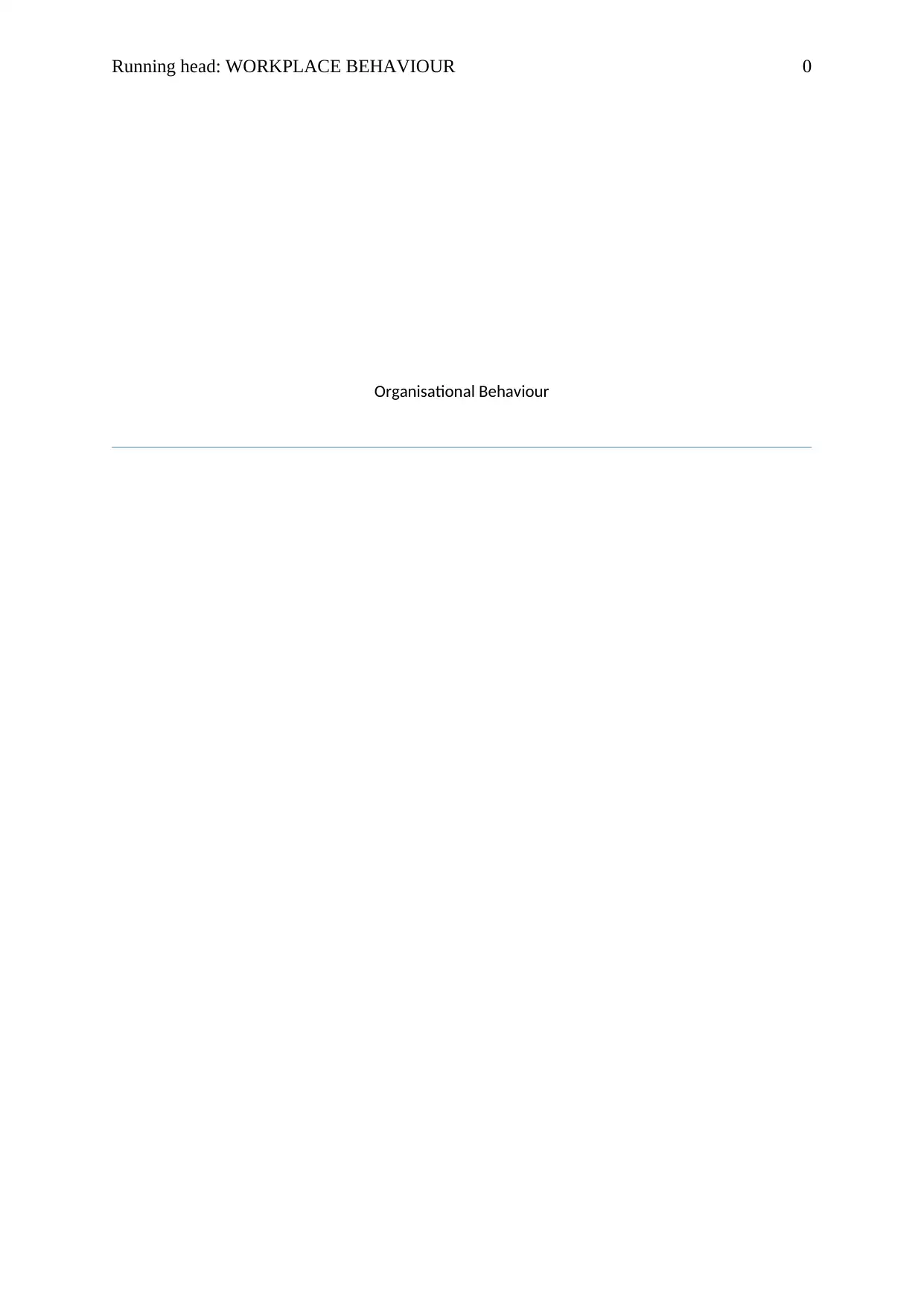
Running head: WORKPLACE BEHAVIOUR 0
Organisational Behaviour
Organisational Behaviour
Paraphrase This Document
Need a fresh take? Get an instant paraphrase of this document with our AI Paraphraser

WORKPLACE BEHAVIOUR 1
Contents
Introduction................................................................................................................................2
Organisational Behaviour, Attitude, and Satisfaction at Workplace.........................................3
Conclusion..................................................................................................................................7
References..................................................................................................................................8
Contents
Introduction................................................................................................................................2
Organisational Behaviour, Attitude, and Satisfaction at Workplace.........................................3
Conclusion..................................................................................................................................7
References..................................................................................................................................8
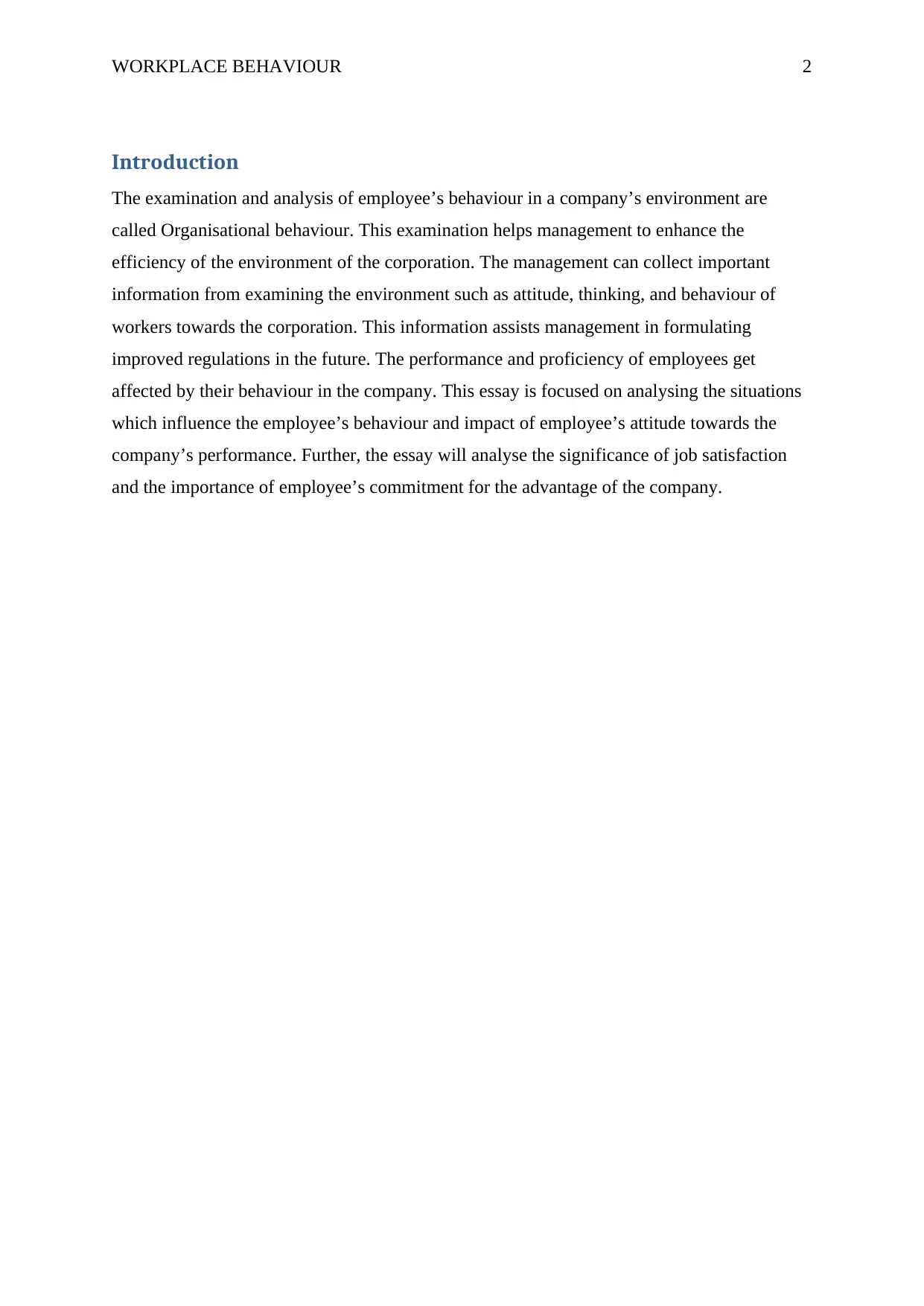
WORKPLACE BEHAVIOUR 2
Introduction
The examination and analysis of employee’s behaviour in a company’s environment are
called Organisational behaviour. This examination helps management to enhance the
efficiency of the environment of the corporation. The management can collect important
information from examining the environment such as attitude, thinking, and behaviour of
workers towards the corporation. This information assists management in formulating
improved regulations in the future. The performance and proficiency of employees get
affected by their behaviour in the company. This essay is focused on analysing the situations
which influence the employee’s behaviour and impact of employee’s attitude towards the
company’s performance. Further, the essay will analyse the significance of job satisfaction
and the importance of employee’s commitment for the advantage of the company.
Introduction
The examination and analysis of employee’s behaviour in a company’s environment are
called Organisational behaviour. This examination helps management to enhance the
efficiency of the environment of the corporation. The management can collect important
information from examining the environment such as attitude, thinking, and behaviour of
workers towards the corporation. This information assists management in formulating
improved regulations in the future. The performance and proficiency of employees get
affected by their behaviour in the company. This essay is focused on analysing the situations
which influence the employee’s behaviour and impact of employee’s attitude towards the
company’s performance. Further, the essay will analyse the significance of job satisfaction
and the importance of employee’s commitment for the advantage of the company.
⊘ This is a preview!⊘
Do you want full access?
Subscribe today to unlock all pages.

Trusted by 1+ million students worldwide
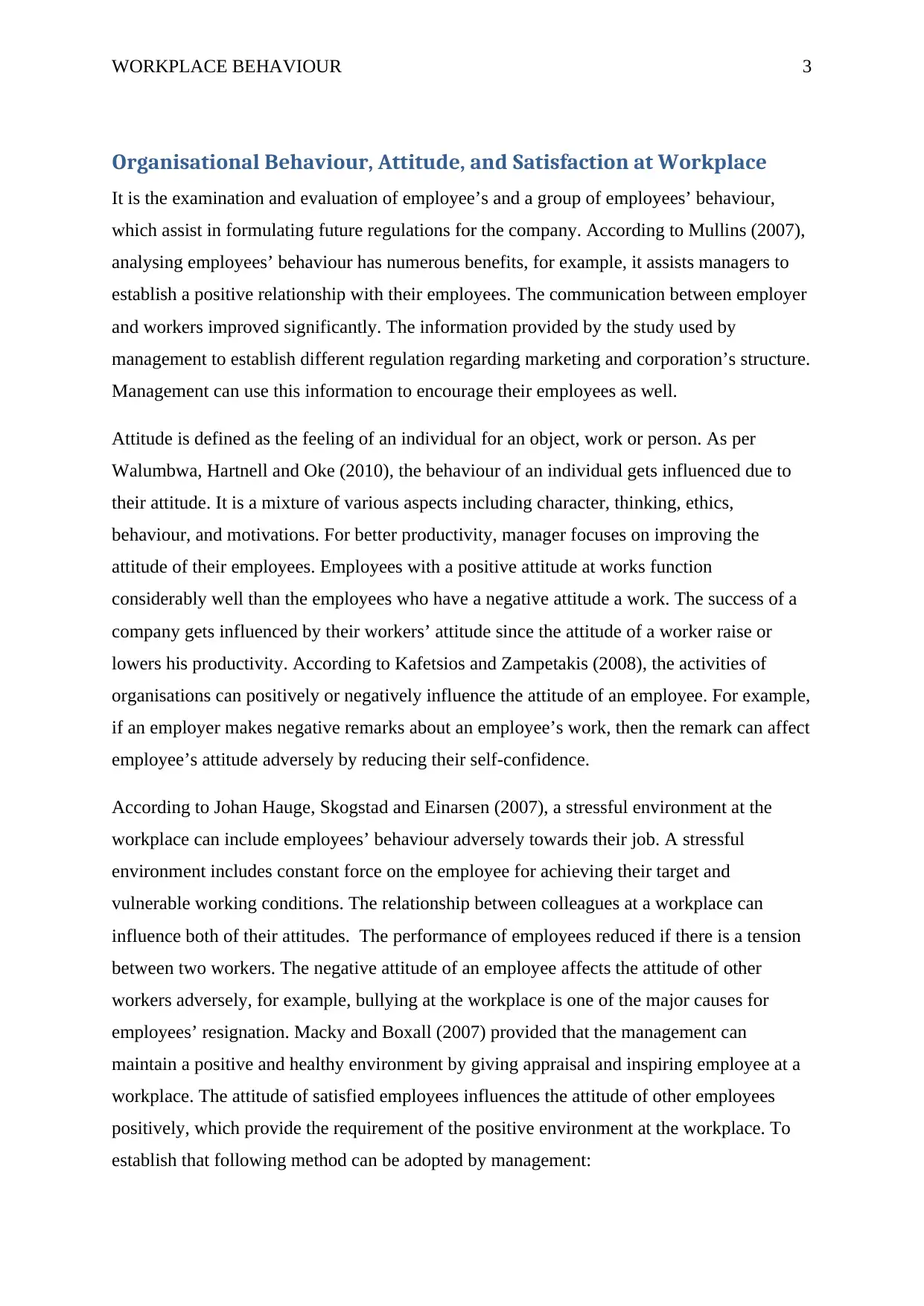
WORKPLACE BEHAVIOUR 3
Organisational Behaviour, Attitude, and Satisfaction at Workplace
It is the examination and evaluation of employee’s and a group of employees’ behaviour,
which assist in formulating future regulations for the company. According to Mullins (2007),
analysing employees’ behaviour has numerous benefits, for example, it assists managers to
establish a positive relationship with their employees. The communication between employer
and workers improved significantly. The information provided by the study used by
management to establish different regulation regarding marketing and corporation’s structure.
Management can use this information to encourage their employees as well.
Attitude is defined as the feeling of an individual for an object, work or person. As per
Walumbwa, Hartnell and Oke (2010), the behaviour of an individual gets influenced due to
their attitude. It is a mixture of various aspects including character, thinking, ethics,
behaviour, and motivations. For better productivity, manager focuses on improving the
attitude of their employees. Employees with a positive attitude at works function
considerably well than the employees who have a negative attitude a work. The success of a
company gets influenced by their workers’ attitude since the attitude of a worker raise or
lowers his productivity. According to Kafetsios and Zampetakis (2008), the activities of
organisations can positively or negatively influence the attitude of an employee. For example,
if an employer makes negative remarks about an employee’s work, then the remark can affect
employee’s attitude adversely by reducing their self-confidence.
According to Johan Hauge, Skogstad and Einarsen (2007), a stressful environment at the
workplace can include employees’ behaviour adversely towards their job. A stressful
environment includes constant force on the employee for achieving their target and
vulnerable working conditions. The relationship between colleagues at a workplace can
influence both of their attitudes. The performance of employees reduced if there is a tension
between two workers. The negative attitude of an employee affects the attitude of other
workers adversely, for example, bullying at the workplace is one of the major causes for
employees’ resignation. Macky and Boxall (2007) provided that the management can
maintain a positive and healthy environment by giving appraisal and inspiring employee at a
workplace. The attitude of satisfied employees influences the attitude of other employees
positively, which provide the requirement of the positive environment at the workplace. To
establish that following method can be adopted by management:
Organisational Behaviour, Attitude, and Satisfaction at Workplace
It is the examination and evaluation of employee’s and a group of employees’ behaviour,
which assist in formulating future regulations for the company. According to Mullins (2007),
analysing employees’ behaviour has numerous benefits, for example, it assists managers to
establish a positive relationship with their employees. The communication between employer
and workers improved significantly. The information provided by the study used by
management to establish different regulation regarding marketing and corporation’s structure.
Management can use this information to encourage their employees as well.
Attitude is defined as the feeling of an individual for an object, work or person. As per
Walumbwa, Hartnell and Oke (2010), the behaviour of an individual gets influenced due to
their attitude. It is a mixture of various aspects including character, thinking, ethics,
behaviour, and motivations. For better productivity, manager focuses on improving the
attitude of their employees. Employees with a positive attitude at works function
considerably well than the employees who have a negative attitude a work. The success of a
company gets influenced by their workers’ attitude since the attitude of a worker raise or
lowers his productivity. According to Kafetsios and Zampetakis (2008), the activities of
organisations can positively or negatively influence the attitude of an employee. For example,
if an employer makes negative remarks about an employee’s work, then the remark can affect
employee’s attitude adversely by reducing their self-confidence.
According to Johan Hauge, Skogstad and Einarsen (2007), a stressful environment at the
workplace can include employees’ behaviour adversely towards their job. A stressful
environment includes constant force on the employee for achieving their target and
vulnerable working conditions. The relationship between colleagues at a workplace can
influence both of their attitudes. The performance of employees reduced if there is a tension
between two workers. The negative attitude of an employee affects the attitude of other
workers adversely, for example, bullying at the workplace is one of the major causes for
employees’ resignation. Macky and Boxall (2007) provided that the management can
maintain a positive and healthy environment by giving appraisal and inspiring employee at a
workplace. The attitude of satisfied employees influences the attitude of other employees
positively, which provide the requirement of the positive environment at the workplace. To
establish that following method can be adopted by management:
Paraphrase This Document
Need a fresh take? Get an instant paraphrase of this document with our AI Paraphraser
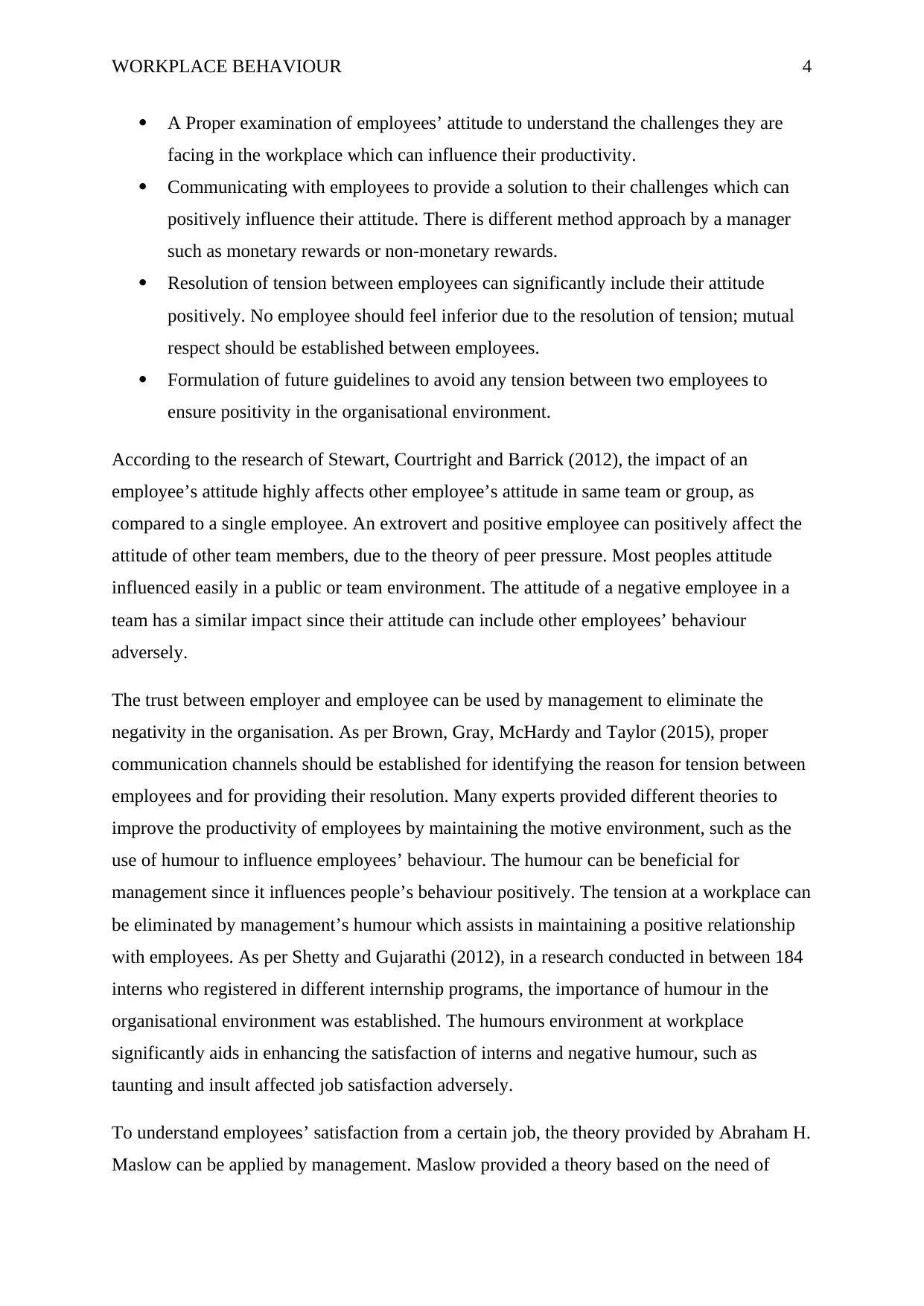
WORKPLACE BEHAVIOUR 4
A Proper examination of employees’ attitude to understand the challenges they are
facing in the workplace which can influence their productivity.
Communicating with employees to provide a solution to their challenges which can
positively influence their attitude. There is different method approach by a manager
such as monetary rewards or non-monetary rewards.
Resolution of tension between employees can significantly include their attitude
positively. No employee should feel inferior due to the resolution of tension; mutual
respect should be established between employees.
Formulation of future guidelines to avoid any tension between two employees to
ensure positivity in the organisational environment.
According to the research of Stewart, Courtright and Barrick (2012), the impact of an
employee’s attitude highly affects other employee’s attitude in same team or group, as
compared to a single employee. An extrovert and positive employee can positively affect the
attitude of other team members, due to the theory of peer pressure. Most peoples attitude
influenced easily in a public or team environment. The attitude of a negative employee in a
team has a similar impact since their attitude can include other employees’ behaviour
adversely.
The trust between employer and employee can be used by management to eliminate the
negativity in the organisation. As per Brown, Gray, McHardy and Taylor (2015), proper
communication channels should be established for identifying the reason for tension between
employees and for providing their resolution. Many experts provided different theories to
improve the productivity of employees by maintaining the motive environment, such as the
use of humour to influence employees’ behaviour. The humour can be beneficial for
management since it influences people’s behaviour positively. The tension at a workplace can
be eliminated by management’s humour which assists in maintaining a positive relationship
with employees. As per Shetty and Gujarathi (2012), in a research conducted in between 184
interns who registered in different internship programs, the importance of humour in the
organisational environment was established. The humours environment at workplace
significantly aids in enhancing the satisfaction of interns and negative humour, such as
taunting and insult affected job satisfaction adversely.
To understand employees’ satisfaction from a certain job, the theory provided by Abraham H.
Maslow can be applied by management. Maslow provided a theory based on the need of
A Proper examination of employees’ attitude to understand the challenges they are
facing in the workplace which can influence their productivity.
Communicating with employees to provide a solution to their challenges which can
positively influence their attitude. There is different method approach by a manager
such as monetary rewards or non-monetary rewards.
Resolution of tension between employees can significantly include their attitude
positively. No employee should feel inferior due to the resolution of tension; mutual
respect should be established between employees.
Formulation of future guidelines to avoid any tension between two employees to
ensure positivity in the organisational environment.
According to the research of Stewart, Courtright and Barrick (2012), the impact of an
employee’s attitude highly affects other employee’s attitude in same team or group, as
compared to a single employee. An extrovert and positive employee can positively affect the
attitude of other team members, due to the theory of peer pressure. Most peoples attitude
influenced easily in a public or team environment. The attitude of a negative employee in a
team has a similar impact since their attitude can include other employees’ behaviour
adversely.
The trust between employer and employee can be used by management to eliminate the
negativity in the organisation. As per Brown, Gray, McHardy and Taylor (2015), proper
communication channels should be established for identifying the reason for tension between
employees and for providing their resolution. Many experts provided different theories to
improve the productivity of employees by maintaining the motive environment, such as the
use of humour to influence employees’ behaviour. The humour can be beneficial for
management since it influences people’s behaviour positively. The tension at a workplace can
be eliminated by management’s humour which assists in maintaining a positive relationship
with employees. As per Shetty and Gujarathi (2012), in a research conducted in between 184
interns who registered in different internship programs, the importance of humour in the
organisational environment was established. The humours environment at workplace
significantly aids in enhancing the satisfaction of interns and negative humour, such as
taunting and insult affected job satisfaction adversely.
To understand employees’ satisfaction from a certain job, the theory provided by Abraham H.
Maslow can be applied by management. Maslow provided a theory based on the need of
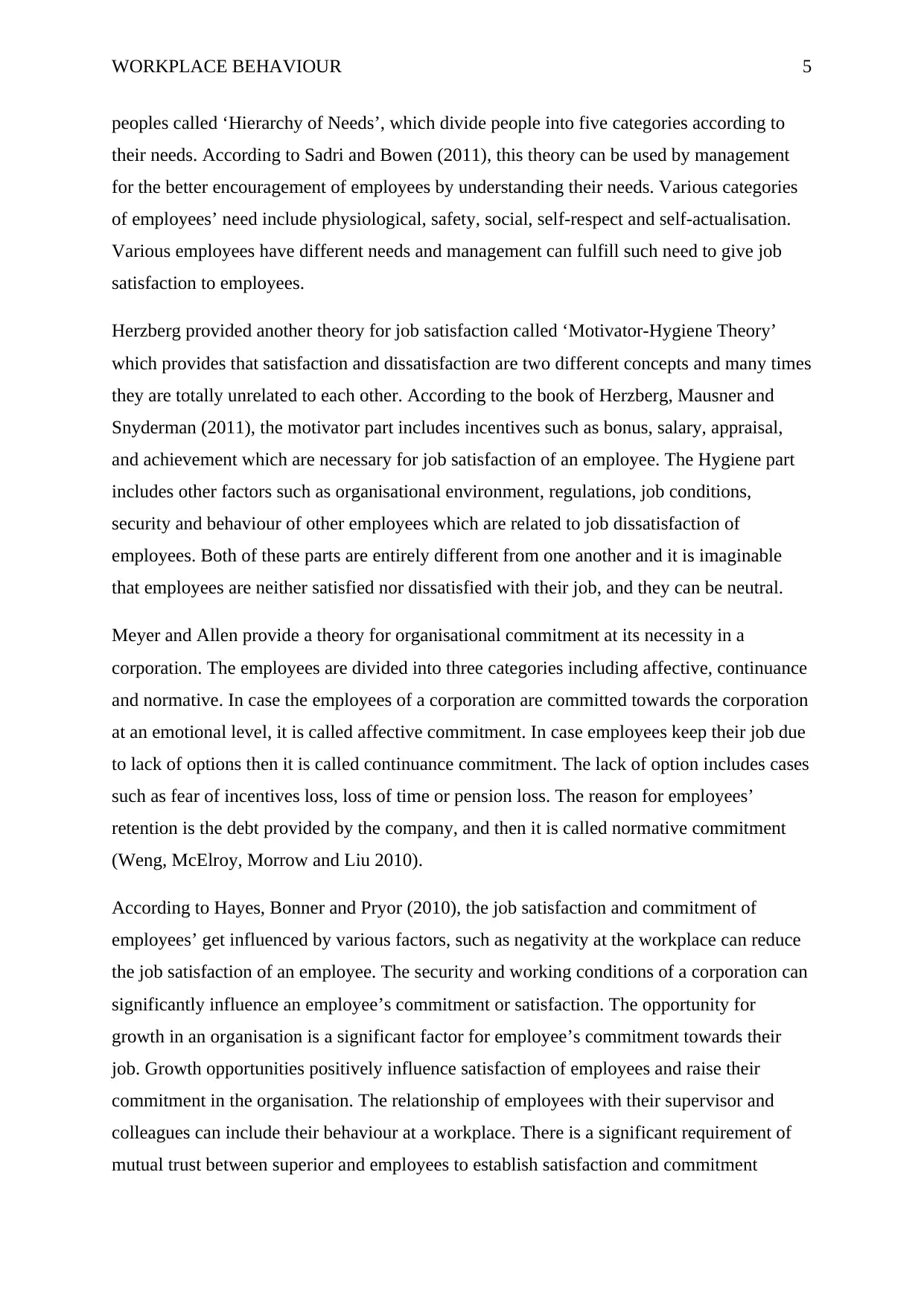
WORKPLACE BEHAVIOUR 5
peoples called ‘Hierarchy of Needs’, which divide people into five categories according to
their needs. According to Sadri and Bowen (2011), this theory can be used by management
for the better encouragement of employees by understanding their needs. Various categories
of employees’ need include physiological, safety, social, self-respect and self-actualisation.
Various employees have different needs and management can fulfill such need to give job
satisfaction to employees.
Herzberg provided another theory for job satisfaction called ‘Motivator-Hygiene Theory’
which provides that satisfaction and dissatisfaction are two different concepts and many times
they are totally unrelated to each other. According to the book of Herzberg, Mausner and
Snyderman (2011), the motivator part includes incentives such as bonus, salary, appraisal,
and achievement which are necessary for job satisfaction of an employee. The Hygiene part
includes other factors such as organisational environment, regulations, job conditions,
security and behaviour of other employees which are related to job dissatisfaction of
employees. Both of these parts are entirely different from one another and it is imaginable
that employees are neither satisfied nor dissatisfied with their job, and they can be neutral.
Meyer and Allen provide a theory for organisational commitment at its necessity in a
corporation. The employees are divided into three categories including affective, continuance
and normative. In case the employees of a corporation are committed towards the corporation
at an emotional level, it is called affective commitment. In case employees keep their job due
to lack of options then it is called continuance commitment. The lack of option includes cases
such as fear of incentives loss, loss of time or pension loss. The reason for employees’
retention is the debt provided by the company, and then it is called normative commitment
(Weng, McElroy, Morrow and Liu 2010).
According to Hayes, Bonner and Pryor (2010), the job satisfaction and commitment of
employees’ get influenced by various factors, such as negativity at the workplace can reduce
the job satisfaction of an employee. The security and working conditions of a corporation can
significantly influence an employee’s commitment or satisfaction. The opportunity for
growth in an organisation is a significant factor for employee’s commitment towards their
job. Growth opportunities positively influence satisfaction of employees and raise their
commitment in the organisation. The relationship of employees with their supervisor and
colleagues can include their behaviour at a workplace. There is a significant requirement of
mutual trust between superior and employees to establish satisfaction and commitment
peoples called ‘Hierarchy of Needs’, which divide people into five categories according to
their needs. According to Sadri and Bowen (2011), this theory can be used by management
for the better encouragement of employees by understanding their needs. Various categories
of employees’ need include physiological, safety, social, self-respect and self-actualisation.
Various employees have different needs and management can fulfill such need to give job
satisfaction to employees.
Herzberg provided another theory for job satisfaction called ‘Motivator-Hygiene Theory’
which provides that satisfaction and dissatisfaction are two different concepts and many times
they are totally unrelated to each other. According to the book of Herzberg, Mausner and
Snyderman (2011), the motivator part includes incentives such as bonus, salary, appraisal,
and achievement which are necessary for job satisfaction of an employee. The Hygiene part
includes other factors such as organisational environment, regulations, job conditions,
security and behaviour of other employees which are related to job dissatisfaction of
employees. Both of these parts are entirely different from one another and it is imaginable
that employees are neither satisfied nor dissatisfied with their job, and they can be neutral.
Meyer and Allen provide a theory for organisational commitment at its necessity in a
corporation. The employees are divided into three categories including affective, continuance
and normative. In case the employees of a corporation are committed towards the corporation
at an emotional level, it is called affective commitment. In case employees keep their job due
to lack of options then it is called continuance commitment. The lack of option includes cases
such as fear of incentives loss, loss of time or pension loss. The reason for employees’
retention is the debt provided by the company, and then it is called normative commitment
(Weng, McElroy, Morrow and Liu 2010).
According to Hayes, Bonner and Pryor (2010), the job satisfaction and commitment of
employees’ get influenced by various factors, such as negativity at the workplace can reduce
the job satisfaction of an employee. The security and working conditions of a corporation can
significantly influence an employee’s commitment or satisfaction. The opportunity for
growth in an organisation is a significant factor for employee’s commitment towards their
job. Growth opportunities positively influence satisfaction of employees and raise their
commitment in the organisation. The relationship of employees with their supervisor and
colleagues can include their behaviour at a workplace. There is a significant requirement of
mutual trust between superior and employees to establish satisfaction and commitment
⊘ This is a preview!⊘
Do you want full access?
Subscribe today to unlock all pages.

Trusted by 1+ million students worldwide
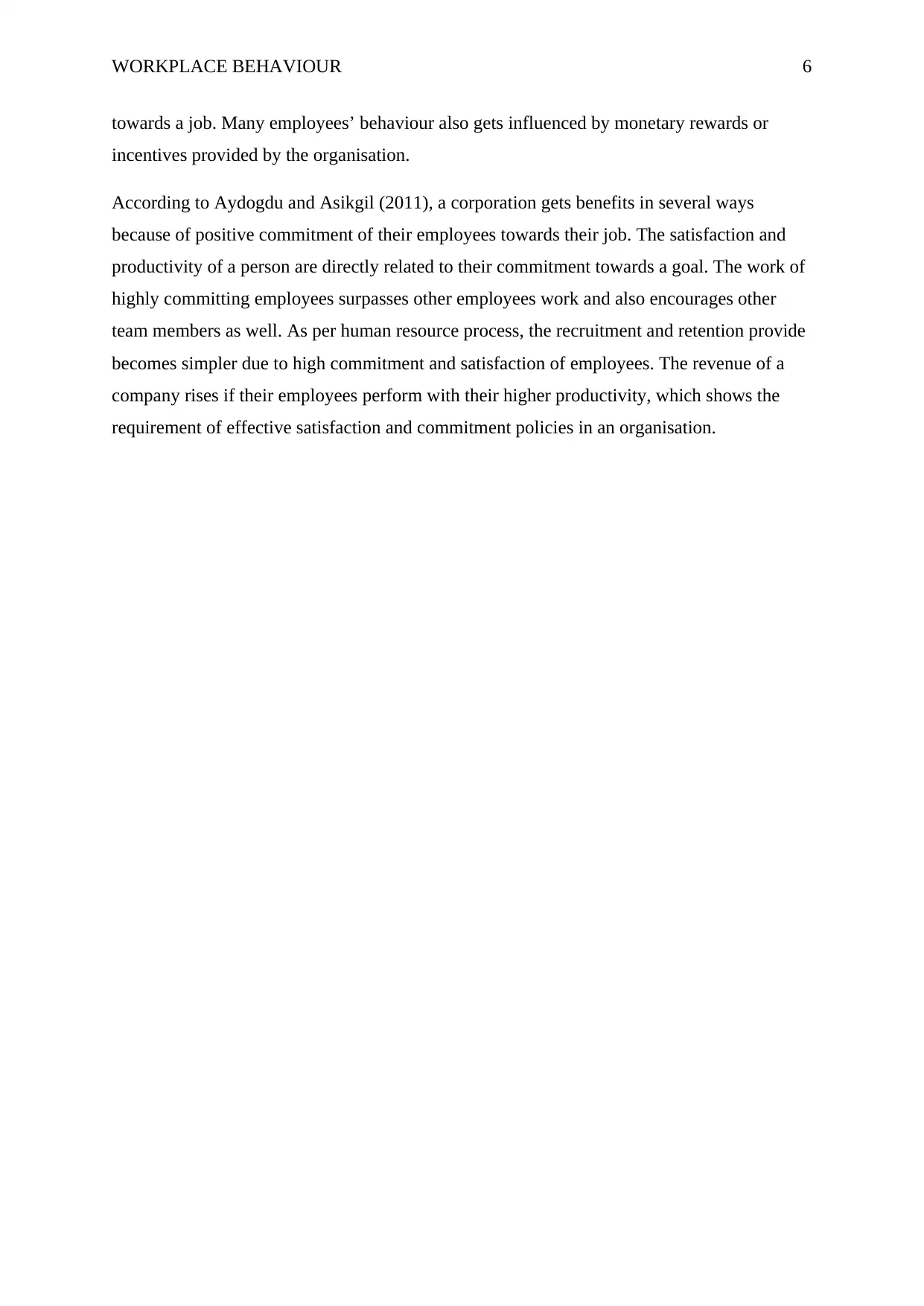
WORKPLACE BEHAVIOUR 6
towards a job. Many employees’ behaviour also gets influenced by monetary rewards or
incentives provided by the organisation.
According to Aydogdu and Asikgil (2011), a corporation gets benefits in several ways
because of positive commitment of their employees towards their job. The satisfaction and
productivity of a person are directly related to their commitment towards a goal. The work of
highly committing employees surpasses other employees work and also encourages other
team members as well. As per human resource process, the recruitment and retention provide
becomes simpler due to high commitment and satisfaction of employees. The revenue of a
company rises if their employees perform with their higher productivity, which shows the
requirement of effective satisfaction and commitment policies in an organisation.
towards a job. Many employees’ behaviour also gets influenced by monetary rewards or
incentives provided by the organisation.
According to Aydogdu and Asikgil (2011), a corporation gets benefits in several ways
because of positive commitment of their employees towards their job. The satisfaction and
productivity of a person are directly related to their commitment towards a goal. The work of
highly committing employees surpasses other employees work and also encourages other
team members as well. As per human resource process, the recruitment and retention provide
becomes simpler due to high commitment and satisfaction of employees. The revenue of a
company rises if their employees perform with their higher productivity, which shows the
requirement of effective satisfaction and commitment policies in an organisation.
Paraphrase This Document
Need a fresh take? Get an instant paraphrase of this document with our AI Paraphraser
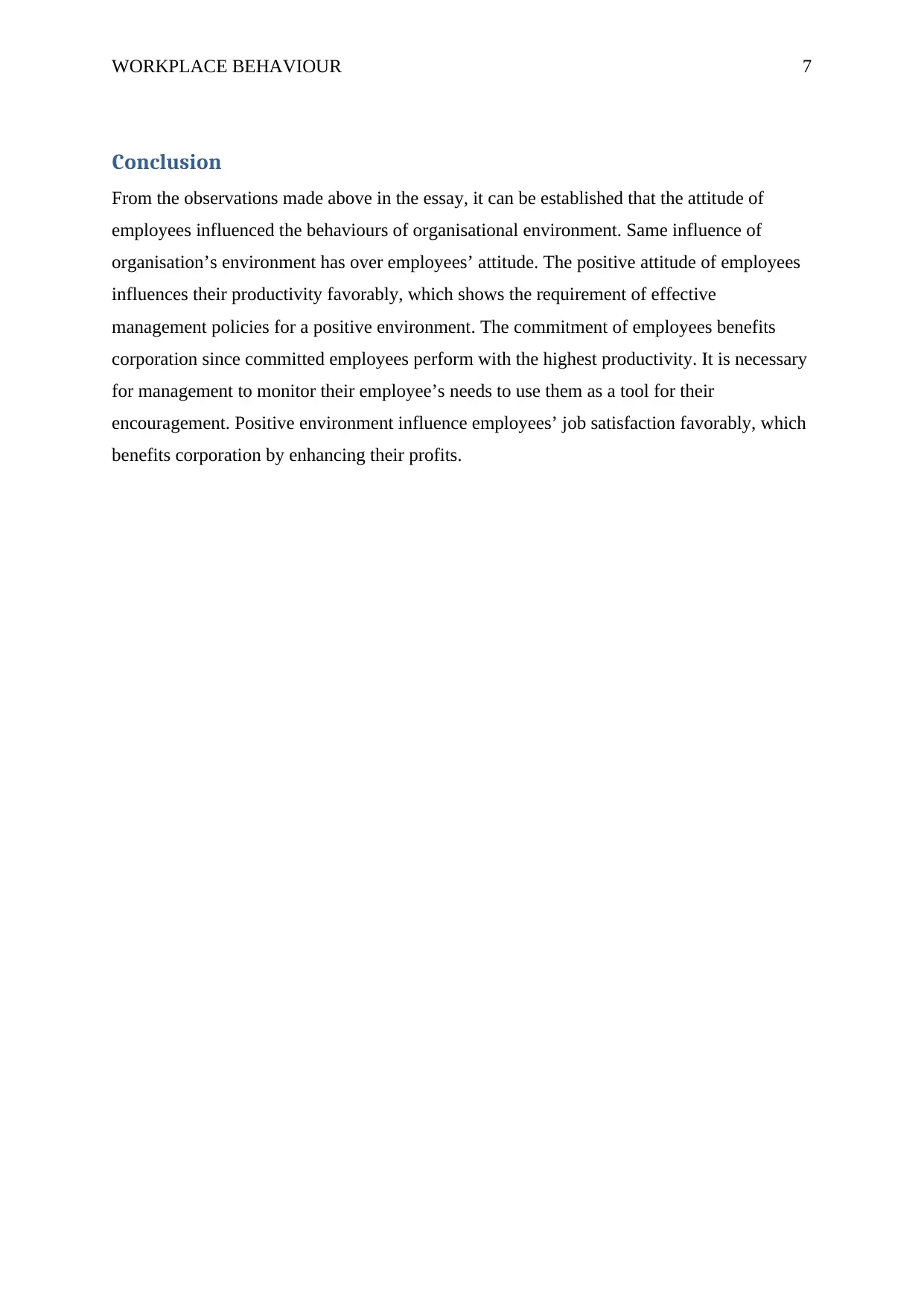
WORKPLACE BEHAVIOUR 7
Conclusion
From the observations made above in the essay, it can be established that the attitude of
employees influenced the behaviours of organisational environment. Same influence of
organisation’s environment has over employees’ attitude. The positive attitude of employees
influences their productivity favorably, which shows the requirement of effective
management policies for a positive environment. The commitment of employees benefits
corporation since committed employees perform with the highest productivity. It is necessary
for management to monitor their employee’s needs to use them as a tool for their
encouragement. Positive environment influence employees’ job satisfaction favorably, which
benefits corporation by enhancing their profits.
Conclusion
From the observations made above in the essay, it can be established that the attitude of
employees influenced the behaviours of organisational environment. Same influence of
organisation’s environment has over employees’ attitude. The positive attitude of employees
influences their productivity favorably, which shows the requirement of effective
management policies for a positive environment. The commitment of employees benefits
corporation since committed employees perform with the highest productivity. It is necessary
for management to monitor their employee’s needs to use them as a tool for their
encouragement. Positive environment influence employees’ job satisfaction favorably, which
benefits corporation by enhancing their profits.
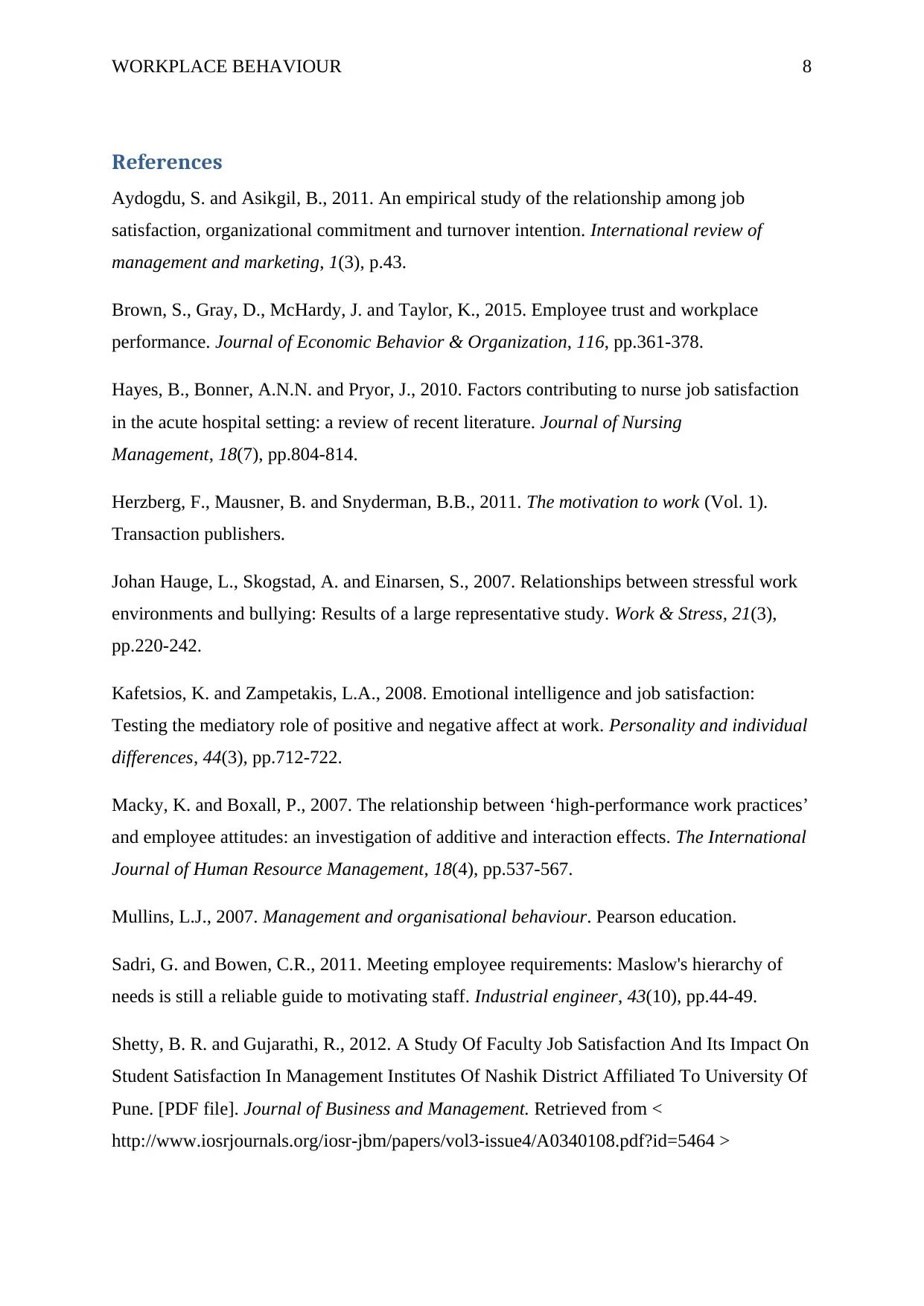
WORKPLACE BEHAVIOUR 8
References
Aydogdu, S. and Asikgil, B., 2011. An empirical study of the relationship among job
satisfaction, organizational commitment and turnover intention. International review of
management and marketing, 1(3), p.43.
Brown, S., Gray, D., McHardy, J. and Taylor, K., 2015. Employee trust and workplace
performance. Journal of Economic Behavior & Organization, 116, pp.361-378.
Hayes, B., Bonner, A.N.N. and Pryor, J., 2010. Factors contributing to nurse job satisfaction
in the acute hospital setting: a review of recent literature. Journal of Nursing
Management, 18(7), pp.804-814.
Herzberg, F., Mausner, B. and Snyderman, B.B., 2011. The motivation to work (Vol. 1).
Transaction publishers.
Johan Hauge, L., Skogstad, A. and Einarsen, S., 2007. Relationships between stressful work
environments and bullying: Results of a large representative study. Work & Stress, 21(3),
pp.220-242.
Kafetsios, K. and Zampetakis, L.A., 2008. Emotional intelligence and job satisfaction:
Testing the mediatory role of positive and negative affect at work. Personality and individual
differences, 44(3), pp.712-722.
Macky, K. and Boxall, P., 2007. The relationship between ‘high-performance work practices’
and employee attitudes: an investigation of additive and interaction effects. The International
Journal of Human Resource Management, 18(4), pp.537-567.
Mullins, L.J., 2007. Management and organisational behaviour. Pearson education.
Sadri, G. and Bowen, C.R., 2011. Meeting employee requirements: Maslow's hierarchy of
needs is still a reliable guide to motivating staff. Industrial engineer, 43(10), pp.44-49.
Shetty, B. R. and Gujarathi, R., 2012. A Study Of Faculty Job Satisfaction And Its Impact On
Student Satisfaction In Management Institutes Of Nashik District Affiliated To University Of
Pune. [PDF file]. Journal of Business and Management. Retrieved from <
http://www.iosrjournals.org/iosr-jbm/papers/vol3-issue4/A0340108.pdf?id=5464 >
References
Aydogdu, S. and Asikgil, B., 2011. An empirical study of the relationship among job
satisfaction, organizational commitment and turnover intention. International review of
management and marketing, 1(3), p.43.
Brown, S., Gray, D., McHardy, J. and Taylor, K., 2015. Employee trust and workplace
performance. Journal of Economic Behavior & Organization, 116, pp.361-378.
Hayes, B., Bonner, A.N.N. and Pryor, J., 2010. Factors contributing to nurse job satisfaction
in the acute hospital setting: a review of recent literature. Journal of Nursing
Management, 18(7), pp.804-814.
Herzberg, F., Mausner, B. and Snyderman, B.B., 2011. The motivation to work (Vol. 1).
Transaction publishers.
Johan Hauge, L., Skogstad, A. and Einarsen, S., 2007. Relationships between stressful work
environments and bullying: Results of a large representative study. Work & Stress, 21(3),
pp.220-242.
Kafetsios, K. and Zampetakis, L.A., 2008. Emotional intelligence and job satisfaction:
Testing the mediatory role of positive and negative affect at work. Personality and individual
differences, 44(3), pp.712-722.
Macky, K. and Boxall, P., 2007. The relationship between ‘high-performance work practices’
and employee attitudes: an investigation of additive and interaction effects. The International
Journal of Human Resource Management, 18(4), pp.537-567.
Mullins, L.J., 2007. Management and organisational behaviour. Pearson education.
Sadri, G. and Bowen, C.R., 2011. Meeting employee requirements: Maslow's hierarchy of
needs is still a reliable guide to motivating staff. Industrial engineer, 43(10), pp.44-49.
Shetty, B. R. and Gujarathi, R., 2012. A Study Of Faculty Job Satisfaction And Its Impact On
Student Satisfaction In Management Institutes Of Nashik District Affiliated To University Of
Pune. [PDF file]. Journal of Business and Management. Retrieved from <
http://www.iosrjournals.org/iosr-jbm/papers/vol3-issue4/A0340108.pdf?id=5464 >
⊘ This is a preview!⊘
Do you want full access?
Subscribe today to unlock all pages.

Trusted by 1+ million students worldwide
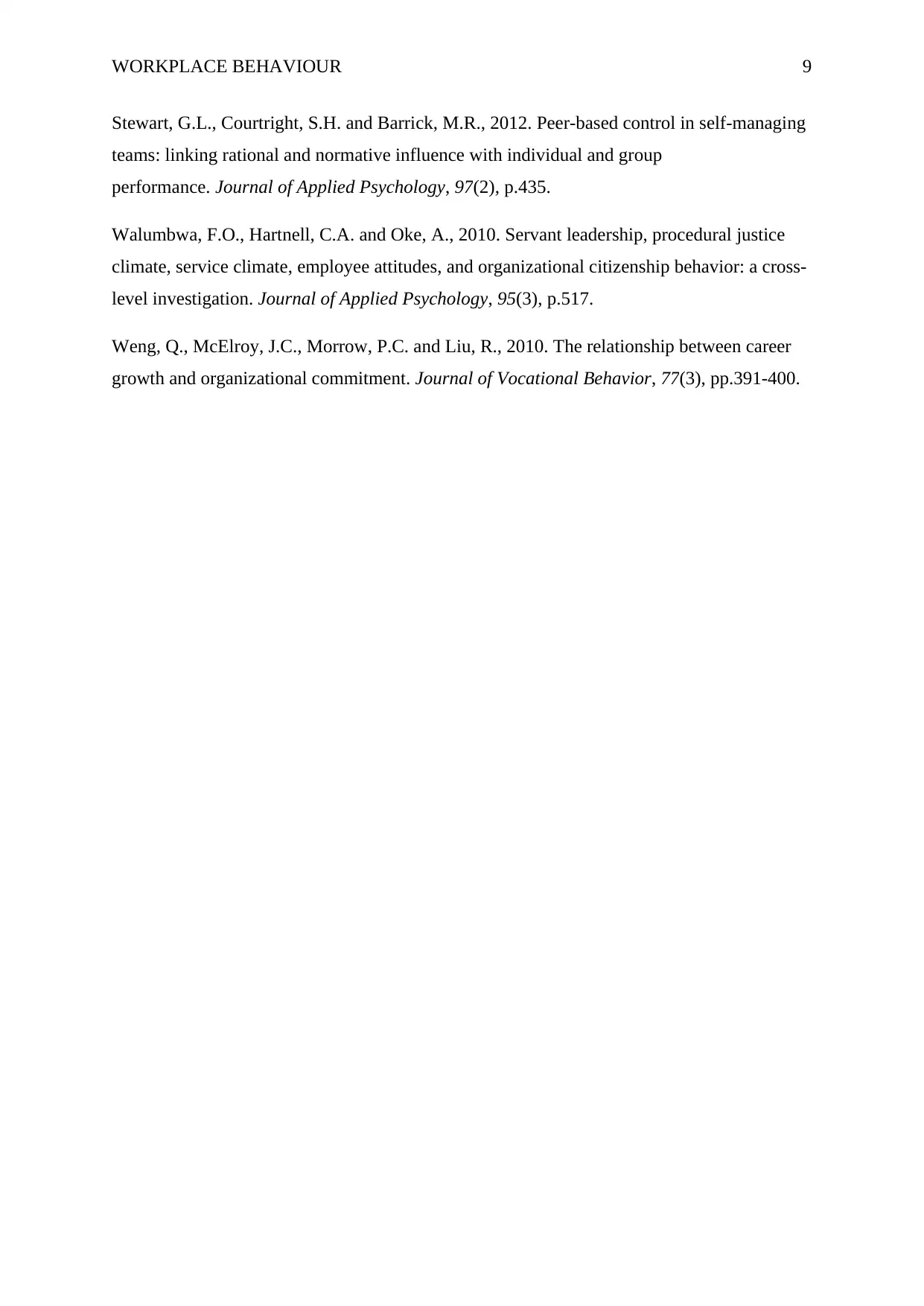
WORKPLACE BEHAVIOUR 9
Stewart, G.L., Courtright, S.H. and Barrick, M.R., 2012. Peer-based control in self-managing
teams: linking rational and normative influence with individual and group
performance. Journal of Applied Psychology, 97(2), p.435.
Walumbwa, F.O., Hartnell, C.A. and Oke, A., 2010. Servant leadership, procedural justice
climate, service climate, employee attitudes, and organizational citizenship behavior: a cross-
level investigation. Journal of Applied Psychology, 95(3), p.517.
Weng, Q., McElroy, J.C., Morrow, P.C. and Liu, R., 2010. The relationship between career
growth and organizational commitment. Journal of Vocational Behavior, 77(3), pp.391-400.
Stewart, G.L., Courtright, S.H. and Barrick, M.R., 2012. Peer-based control in self-managing
teams: linking rational and normative influence with individual and group
performance. Journal of Applied Psychology, 97(2), p.435.
Walumbwa, F.O., Hartnell, C.A. and Oke, A., 2010. Servant leadership, procedural justice
climate, service climate, employee attitudes, and organizational citizenship behavior: a cross-
level investigation. Journal of Applied Psychology, 95(3), p.517.
Weng, Q., McElroy, J.C., Morrow, P.C. and Liu, R., 2010. The relationship between career
growth and organizational commitment. Journal of Vocational Behavior, 77(3), pp.391-400.
1 out of 10
Related Documents
Your All-in-One AI-Powered Toolkit for Academic Success.
+13062052269
info@desklib.com
Available 24*7 on WhatsApp / Email
![[object Object]](/_next/static/media/star-bottom.7253800d.svg)
Unlock your academic potential
Copyright © 2020–2025 A2Z Services. All Rights Reserved. Developed and managed by ZUCOL.





